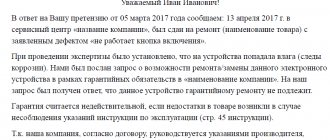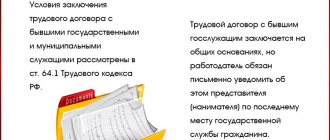Modern department
The personnel service is a set of structural units designed to manage personnel. With the change in guidelines and tasks in employee management, the tasks of the personnel department, its structure and functionality have also changed. We are talking about the creation of a multifunctional unit at enterprises and organizations, as well as the coordination (organization) of the activities of all structural divisions in the overall system of employee and production management. Today, the presence of a personnel service in a company is a comprehensive solution not only to the problems of providing the structure with personnel, but also to the main task in modern economic and market conditions. It consists of connecting production development goals with the needs of employees who realize these goals; in organizing the balance of the development strategy of the company (organization, enterprise) and the personnel employed in it.
Functional responsibilities of personnel management system employees
Unfortunately, modern personnel services have employees who lack professional experience in this field. Also, the regulation on the personnel service has a somewhat outdated interpretation, which is why it is quite difficult for modern organizations to be guided by it in their activities. To fully perform their duties, a personnel employee must have good experience not only in the business and professional sphere, but also know how to interact with management, functional and line departments.
The HR service must meet the following requirements:
- Know and be able to use labor legislation, methodological and regulatory developments regarding how to work with employees of the organization.
To successfully complete such a task, personnel officers will need knowledge of the basics of pedagogy, sociology and even psychology. Ability to apply domestic and foreign experience in work.
- Know modern methods of employee evaluation and be able to apply them in practice.
Know what career guidance work is. Engage in long-term and operational planning, while mastering the regulations for the functions of each structural unit. Be able to apply social management technologies.
- Understand what prospects are on the horizon for the organization. Understand the basics of labor from the point of view of scientific organization, as well as have an understanding of the work of structural units.
HR service and personnel management of an enterprise begins with a competent manager. In the modern world, the requirements for such a candidate have increased significantly compared to a decade ago. The organization of a personnel management service at an enterprise today begins with a position such as deputy head of human resources. Special requirements are put forward for such people, since they will not only have to manage their subordinates - HR employees, but also answer many questions related to their work activities.
If we evaluate all of the above objectively, then at present it is worth paying attention to institutions that train personnel. It is important that a university graduate can immediately get a position in his field, otherwise knowledge may simply be lost.
Organizational structure of the personnel management system
What is the organizational structure of the personnel management system? Basically, how many people will be in the personnel department of an enterprise depends on how many vacancies there are in the organizational structure and the Charter of the organization itself. These points are determined by the following factors:
- the total number of people working at a particular enterprise;
- conditions and characteristics of the organization, whether it has additional production facilities and branches;
- characteristics of the enterprise from the point of sociality,
- the structure of the working class in the organization - are there specialists, managers, employees and what is their number in the personnel department;
- the qualification level of each employee;
- functional responsibilities of personnel officers, whether they need to engage in planning, developing personnel policies, organizing internships and training, etc.;
- technical support for labor management.
Each enterprise has the right to independently decide how many personnel are needed in the HR department and what the responsibilities should be. The best option to calculate how many people will be needed for such work is to determine the labor intensity. That is, calculate how much time one employee needs to complete a given task.
HR structure
The structure of the department depends, firstly, on the size of the company (number of staff), and secondly, on the tactical tasks assigned to HR specialists. In small companies, HR administration is entrusted to an accountant or even a secretary. If the company is large, actively developing, interested in quickly and effectively filling vacancies, retaining staff, and developing them, then individual specialists or groups of specialists should work in each of the areas of work, for example:
- HR department (office work);
- labor protection service (a dedicated specialist is required if the organization has more than 50 people on staff);
- recruiting department;
- adaptation department;
- assessment center;
- The educational center;
- Department of Compensation and Benefits.
The service is headed by the HR Director.
Sometimes office management and labor protection are separated into separate structural units that are not subordinate to the HR director.
Personnel management (A. V. Deineka, 2013)
4.2. Stages of personnel selection in an organization
The recruitment of candidates is the basis for the next stage - the selection of future employees of the organization. The content of this stage largely depends on the traditions, characteristics of the organization accepting new employees, as well as on the nature of the position for which the candidate is being selected. However, in general terms, the personnel selection process can be represented by a diagram (Fig. 12). At each stage, some applicants are eliminated or they refuse the procedure, accepting other offers.
Primary selection
begins with an analysis of lists of candidates in terms of their compliance with the organization’s requirements for a future employee. The main purpose of the primary selection is to screen out candidates who do not have the minimum set of characteristics required to fill a vacant position.
Rice. 12.
Typical personnel selection process for an organization
Obviously, this minimum set is different for different specialties and organizations.
Initial selection methods depend on the budget, the organization's strategy and the relative importance of the position. Currently, the most common methods are personal data analysis and testing.
Analysis of personal data
assumes that a person’s biography is a fairly reliable indicator that determines the possibility of successfully performing certain production functions. When using this method, HR specialists analyze the information contained in the questionnaires filled out by candidates, comparing the actual data with their own model. Analysis of personal data is a simple, cheap and quite effective method of primary selection when an organization has an extensive list of candidates and when it comes to specialized positions. At the same time, this method is approximate in assessing potential, since it is focused exclusively on facts from the candidate’s past, and not on his current state and ability for professional development. Therefore, when selecting candidates for leadership positions, especially those involving further development and professional growth, it is necessary to use the questionnaire analysis method with extreme caution.
Testing
has recently gained increasing popularity among leading organizations in developed countries; it is used not only by corporations, but also by government agencies and public organizations. The advantages of testing are the ability to assess the current state of the candidate, taking into account the characteristics of the organization and future position. The disadvantages of this method of primary selection are high costs, often the need for specialist help, conventionality and limited tests that do not give a complete picture of the candidate.
Each organization must make a decision on the use of tests taking into account its own financial capabilities, cultural characteristics, and development priorities.
Three types of tests can be used when hiring:
• on professional knowledge and skills;
• level of development of intelligence and other abilities;
• the presence and degree of manifestation of certain personal qualities.
Qualification tests for assessing the level of professional knowledge and skills are designed to determine the level of professional skill or knowledge of a candidate in specific areas of the labor process, in addition, they allow screening and initial ranking of applicants for a position.
General intelligence tests contain sets of tasks that include mathematical, logical, linguistic and other similar tasks, for which a limited time is allotted (usually from 30 minutes to an hour and a half).
Psychological portraits are of an auxiliary nature when choosing a candidate, but some positions obviously require certain character traits. For example, someone who works directly with an organization's clients should be cheerful, have a lively personality, and a friendly demeanor. Psychological compatibility in a team is of great importance, especially when people must work in close contact or be together for a long time (business trips). Tests for the presence and degree of manifestation of certain personal qualities are designed to determine the personal characteristics of the hired employee. These tests are most often presented in the form of questionnaires. With their help, personality traits or interests are assessed.
The primary selection stage, regardless of the methods used, ends with the creation of a limited list of candidates who best meet the requirements of the organization. The remaining candidates are informed of the decision to cease consideration of their candidacies for this position.
Interview with HR staff
. At this stage, the recruiter conducts individual interviews - interviews with selected candidates. The purpose of these interviews is to assess the degree to which the candidate fits the portrait of an ideal employee, his ability to fulfill the requirements of the job description, potential for professional growth and development, ability to adapt to the organization, familiarity with the candidate's expectations regarding the organization, working conditions, pay, etc. Not Being a technical specialist, the HR employee must focus on assessing the “general characteristics” of the candidate - analytical abilities, character, life philosophy, motivation, ability to work, compatibility with the organization.
It is important to note that the interview is a two-way process - not only does the organization evaluate the candidate, but the candidate also evaluates the organization in terms of its relevance to his own interests and needs. The HR officer conducting the interview must provide the most objective and complete information about the organization in order to interest the candidate and at the same time avoid hiring those whose expectations are at odds with the organization's capabilities.
There are the following types of interviews with candidates:
• one representative of the organization meets with one candidate;
• one representative of the organization meets with several candidates;
• several representatives of the organization talk with one candidate;
• several representatives of the organization interview several candidates.
The one-on-one interview is the most common and quite effective.
In the second case, the interviewer is given the opportunity to simultaneously evaluate several candidates and observe them in a stressful situation (the presence of several applicants for the same position), although it is much more difficult to interview several candidates at the same time.
The participation of several representatives of the organization increases the objectivity of the assessment and the quality of the interview itself, but can create additional stress for the candidate and increases the costs of the organization.
The presence of multiple people on both sides greatly increases the complexity of the interview process and requires careful preparation and consistent behavior among interviewers.
The choice of the type of interview depends on the traditions of the organization, the characteristics of the candidate, the vacant position, and the individual preferences of the interviewer.
Main part
An interview is an exchange of information between its participants.
The interviewer is interested in information that makes it possible to assess the candidate’s ability and desire to work successfully in the organization. Therefore, the end of the interview
should happen at the moment when the interviewer wants it. There are several techniques for this: invite the candidate to ask the last question; start looking at the clock or the door; straighten up, as if about to rise from the table. At the very end of the interview, it is necessary to thank the candidate and explain to him the further procedure for considering his candidacy and maintaining contact with him.
The interview results must contain an assessment of the candidate and a proposal to continue or stop working with him. The conclusion of the interviewer is transferred to the head of the department with the vacancy, who makes a decision on further actions in relation to this candidate.
In order to better assess the professional and personal qualities of a candidate, organizations can make inquiries about the candidate,
that is, seek information from people and organizations who know him from joint studies, work, etc. HR specialists can invite the candidate himself to name the names of people who could characterize him, and then talk with these people.
If the head of the department is satisfied with the results of the interview conducted by the HR employee, he makes an appointment with the candidate. Unlike an interview with personnel management specialists, this interview should allow us to assess, first of all, the professional qualities of the candidate and his ability to perform production functions. At the same time, the manager assesses the degree of his personal professional compatibility with the candidate and the likelihood of the latter’s successful integration into the department. In addition, the manager provides the candidate with detailed information about his department, the vacant position, and the functions that the candidate will have to perform if hired. The results of the interview must be documented. To do this, it is necessary to use special candidate assessment forms.
Recently, the practice of hiring with a probationary period has become increasingly widespread, making it possible to evaluate a candidate directly in the workplace without assuming obligations for his permanent employment. During the probationary period, the duration of which depends on labor legislation, the candidate performs official duties in full, receives remuneration, but can be dismissed at the end of it without any consequences for the organization. During the probationary period, the head of the unit pays special attention to the candidate and evaluates him in terms of suitability for the given position and organization.
Based on an analysis of the interview results, as well as the trial period, the head of the department selects the candidate who, in his opinion, is most suitable for the position. Depending on the importance of the vacant position, an interview with the CEO may be required before a hiring decision is made.









